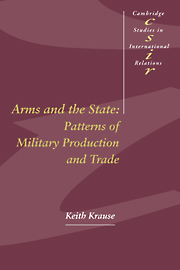Book contents
- Frontmatter
- Contents
- List of figures
- List of tables
- Acknowledgements
- Introduction
- 1 Motive forces in the evolution of the arms transfer and production system
- 2 The emergence of a global arms transfer and production system
- 3 From the Military Revolution to the Industrial Revolution
- 4 An overview of the post-1945 global arms transfer system
- 5 The dominance of first-tier producers and suppliers
- 6 Second-tier producers and suppliers: the struggle to keep pace
- 7 Dependent production and exports in the third tier
- 8 The subordinate role of arms recipients
- Conclusion
- Appendix: Arms transfer data sources and problems
- Notes
- Bibliography
- Index
2 - The emergence of a global arms transfer and production system
Published online by Cambridge University Press: 22 September 2009
- Frontmatter
- Contents
- List of figures
- List of tables
- Acknowledgements
- Introduction
- 1 Motive forces in the evolution of the arms transfer and production system
- 2 The emergence of a global arms transfer and production system
- 3 From the Military Revolution to the Industrial Revolution
- 4 An overview of the post-1945 global arms transfer system
- 5 The dominance of first-tier producers and suppliers
- 6 Second-tier producers and suppliers: the struggle to keep pace
- 7 Dependent production and exports in the third tier
- 8 The subordinate role of arms recipients
- Conclusion
- Appendix: Arms transfer data sources and problems
- Notes
- Bibliography
- Index
Summary
Arms transfers in the pre-modern period
Arms transfers and arms production have appeared as an inevitable concomitant to war and military preparations throughout human history. Although from our vantage point the technologies of warfare in the pre-modern period were primitive, important technological advances and sources of innovation created even then a diffusion of techniques for (and possibly a trade in) arms and armour between Greece, Central Europe and Asia. The significance of improved weaponry was not lost on early rulers, who supported and encouraged military innovation: ‘Hellenistic mechanicians earned their livelihood as military engineers. War industry was lavishly supported … [and] kingdoms and cities competed keenly for the services of the most able engineers, whose rewards, in terms both of money and prestige, were great.’ The first major technology that required such investments was the catapult, which emerged around 399 BC in Syracuse and was soon diffused throughout the Mediterranean. Its impact on war and society may have been great, as ‘improvements in siege craft that promoted the equality or ascendancy of the besieger played a part in the establishment of larger political units’ and the decline of Greek city-states.
The first recorded arms transfers are probably those found in Thucydides' Peloponnesian War. What was transferred, however, was usually not only arms, but men, weapons, supplies and ships. Athens, for example, demanded the supply of specified numbers of ships and men as part of membership in the Delian League.
- Type
- Chapter
- Information
- Arms and the StatePatterns of Military Production and Trade, pp. 34 - 53Publisher: Cambridge University PressPrint publication year: 1992

